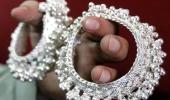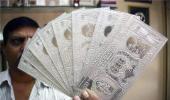Treat silver as part of the procyclical or growth assets in your portfolio, advises Sanjay Kumar Singh.

ICICI Prudential Mutual Fund and Nippon India Mutual Fund have got off the block first with the launch of their silver exchange-traded funds (ETFs) and fund of fund (FoF).
A number of other fund houses like DSP, HDFC, and Mirae will soon come out with their offerings after obtaining the regulator's approval.
A pro-cyclical asset
Even though silver is a part of the precious metal basket, it does not have a negative correlation with stocks, as gold does.
The 10-year data shows it has a low but positive correlation with equities.
"Around 70 per cent of silver's usage comes from industrial applications.
When economic growth is high, rising demand pushes its price up," says Chirag Mehta, senior fund manager-alternative investments, Quantum Mutual Fund.
Investors should not treat silver as a hedge against an equity market downturn. Gold, with its negative correlation, is better suited for that role.
Imperfect hedge against inflation
Over the past 10 years, silver has given a compounded annual return of 1.47 per cent.
Consumer price index-based inflation in India over this period was higher.
Over a longer span, silver has fared better.
"Between January 1990 and December 2021, silver gave a compounded annual return of almost 9.7 per cent in rupee terms, in line with the performance of gold, and can be considered an inflation hedge," says Hemen Bhatia, head - ETF, Nippon India Mutual Fund.
Investors betting on it must be prepared for higher volatility than in gold.
"It has partly the characteristics of an industrial metal and partly that of bullion. Its dual nature makes it volatile," says Naveen Mathur, director-commodities and currencies, Anand Rathi Shares and Stock Brokers.
Outlook likely to improve
Silver has declined 12.5 per cent over the past year.
Experts, however, expect it to begin performing in a few months.
"Silver will continue to be under pressure for the first few months of the year. But it should rise in the second half of 2020," says Kishore Narne, associate director and head of commodities and currency, Motilal Oswal Financial Services.
Mathur expects silver to trade in the range of Rs 60,000 and Rs 67,000 over the next six-eight months.
Invest for commodity exposure
Invest in a silver ETF or FoF if you want exposure to commodities in your portfolio.
"Such an exposure would allow you to benefit from an upturn in the economic and industrial cycle," says Vishal Dhawan, chief financial planner, Plan Ahead Wealth Advisors.
Mehta believes a basket of commodities would provide investors a better hedge against inflation.
It would also ensure better risk-adjusted returns: A dip in demand for one commodity would be balanced out by an upturn in demand for another.
However, no passive fund offering exposure to a basket of commodities is available yet.
According to Mehta, if an investor decides to invest in silver alone, he should do so based on its individual merits as an investment.
"Invest after checking the price, whether the demand-supply scenario is favourable, and if substitution possibilities exist for it in its industrial usage," he says.
Investors will have to time their entry and exit correctly when taking such tactical exposure.
Returns from silver have been poor over the past 10 years.
"But there have been 10-year periods when returns from equities and real estate have also been poor. What this data does indicate is that investors who want a strategic allocation to silver must have at least a 10-year plus horizon. That will improve the probability of a positive outcome," says Dhawan.
Treat silver as part of the procyclical or growth assets in your portfolio.
"Allocate 5-10 per cent of the pro-cyclical component of your portfolio to it," says Dhawan.
An investor who has a 70 per cent allocation to equities in his portfolio may allocate 3.5 to 7 per cent to silver.
Long-term investors should take the systematic investment plan (SIP) route to benefit from its volatility.
The ETF/FoF advantage
Buying silver jewellery or silverware is not an efficient option for investing in silver.
The investor will lose out on the making charges when selling them.
Silver futures available on the MCX are better suited for trading or for short-term hedging, not for long-term investing.
"Rolling over positions will cost a steep 6-8 per cent annually," says Narne.
ETFs and FoFs carry a much lower cost. ICICI Prudential's silver ETF will have an expense ratio of 0.4 per cent.
The direct plan of its FoF will cost 0.43 per cent while the regular plan will cost 1 per cent.
Mathur adds that most retail investors will find futures too complex to deal with.
ETFs and FoFs offer a simple and convenient option for retail investors.
"Since silver is bulky and hence difficult to store, ETF and FoF are the optimal ways to invest in it. Also, one need not worry about purity and quality," says Chintan Haria, head-product and strategy, ICICI Prudential Mutual Fund.
Before investing, check out the expense ratio. Once data on tracking error vis-a-vis the benchmark becomes available, check that also.
For those taking the ETF route, trading volume will be a crucial parameter.
Know the tax implications
Silver ETFs will be taxed similarly as gold ETFs.
"The holding period for categorisation into long-term and short-term capital gain will be 36 months. Long-term capital gains will be taxed at 20 per cent under Section 112 of the Income-Tax Act after availing indexation benefit. Short-term capital gains will be taxed at the investor's slab rates," says Suresh Surana, founder, RSM India. FoFs will be taxed similarly.

Feature Presentation: Aslam Hunani/Rediff.com











